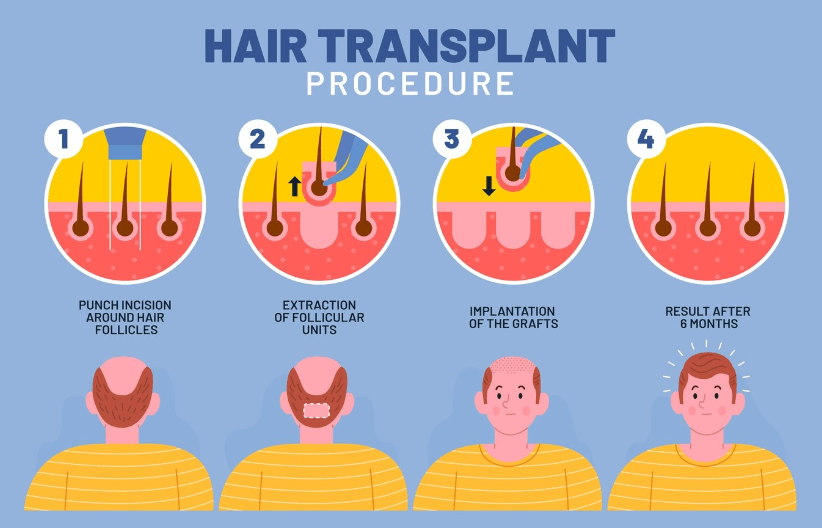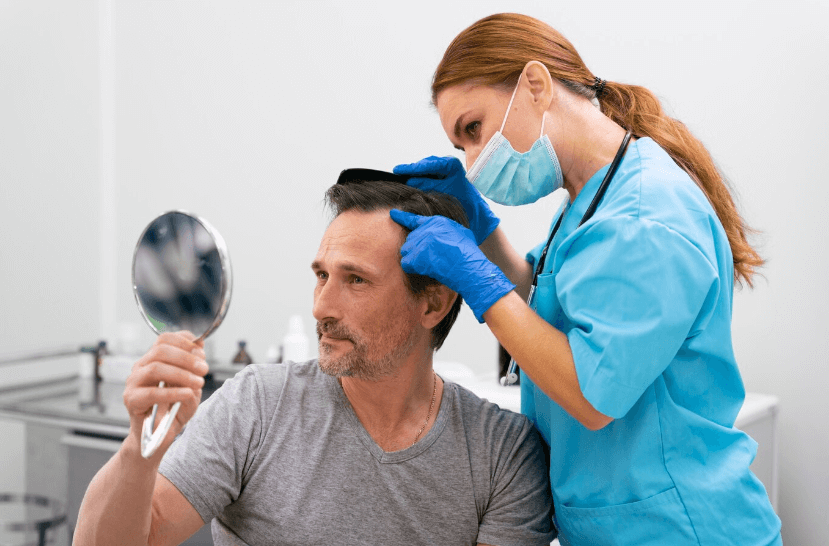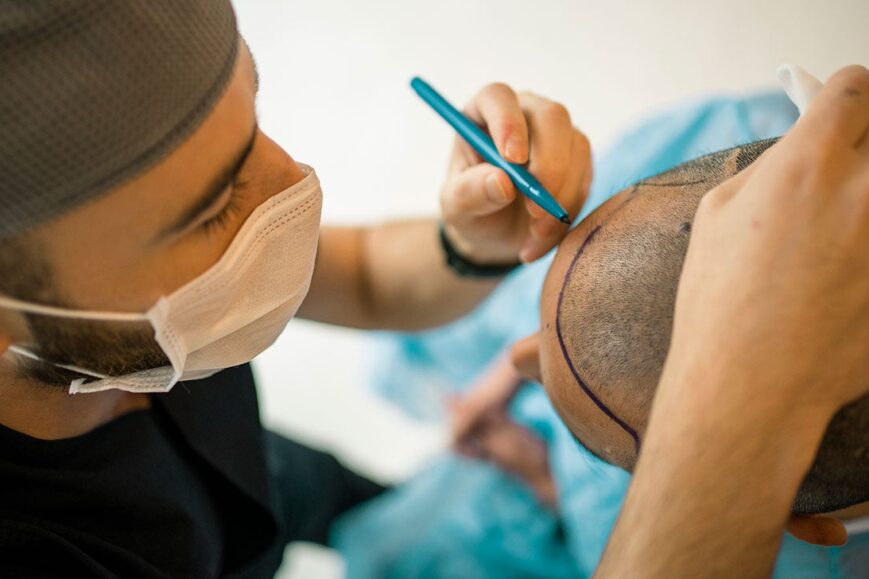A hair transplant is a medical method in which a “donor site” on the body is moved to a “recipient site” experiencing baldness. It’s commonly used for male male-patterns. Grafts with genetically resistant hair follicles are transplanted to the bald scalp in a minimally invasive process.
The fascinating history of hair transplants can be traced back to the 1930s in Japan. Over the years, this field has seen significant advancements. In the 1950s, dermatologist Norman Orentreich’s groundbreaking work demonstrated that hair transplanted from the sides and back of the head is resistant to balding, a discovery that laid the foundation for the modern techniques we use today.
His studies led to the groundbreaking discovery that these transplanted hairs were resistant to the typical balding process, laying the foundation for modern hair transplant techniques.
Follicular Unit Extraction (FUE) involves harvesting individual hair follicles and implanting them into bald areas. Both methods help restore lost hair, boosting self-esteem and confidence.
Follicular unit extraction (FUE) and transplantation (FUT) are today’s most common methods. In FUT, a strip of skin, including hair follicles from the donor location, is removed and divided into separate grafts.
What are Hair Transplants?

Hair transplants work on the principle of “donor dominance,” which means that hair follicles that are genetically resistant to balding are transplanted to balding areas. These transplanted hairs resist the balding process even in their new location. The two main techniques for hair transplantation are as follows:
Hair transplantation is considered a safe and effective treatment for hair loss, providing natural-looking results that can last a lifetime. However, it’s essential to consult with a qualified and experienced surgeon to determine whether you’re a suitable candidate for the procedure and to discuss the potential risks and benefits.
Different types of hair transplants
Hair transplants surgery has evolved, and several techniques are available. Here are the different types of hair transplants:

- Follicular Unit Transplantation (FUT): Also referred to as the “strip method,” follicular unit transplantation (FUT) entails cutting a strip of skin from the donor region, which is often the back of the head, and separating it into individual units. After that, these units are moved to the balding areas.
- Follicular Unit Extraction (FUE): With FUE, a specialized punch instrument is used to remove individual hair follicles from the scalp and put them in the desired location. Compared to FUT, this procedure is less invasive and doesn’t leave any linear scars.
- Slit Grafts: Each slit graft has four to ten hairs. They are usually used to add density to more significant regions of balding, and they are put into slits formed in the scalp.
- Micrografts: Used for finer details, like the hairline, or to subtly enhance density, micrografts have one to two hairs per graft.
- Direct Hair Implantation (DHI): Direct Hair Implantation (DHI) extracts and implants hair follicles using a specialized tool. With more control over each hair follicle’s depth, direction, and angle, this approach creates a more natural-looking hairline.
The patient’s preferences, the amount and quality of the donor’s hair, and the patient’s hair loss pattern all play a role in the technique selection process. Each method has pros and downsides. Speaking with a hair transplant expert is crucial to choosing the best procedure for your unique requirements.
Why are Hair Transplants a Popular Solution for Hair Loss?
Hair transplants are popular because they offer a permanent and natural-looking solution to hair loss. Unlike temporary solutions like wigs or hairpieces, hair transplants grow naturally and can be treated like normal hair. They are particularly favored because:
- They provide lasting results.
- The transplanted hair combines perfectly with the native hair and has a natural appearance.
- It’s a one-time procedure with no need for ongoing treatment.
- Thanks to technological advancements, the operation is now less intrusive and leaves fewer scars.
- It boosts self-confidence and self-image for many individuals.
A licensed hair restoration specialist should be consulted before making such a big decision as hair transplants. They can assist people in regaining their hair and the self-assurance and fulfilment that come with having more hair on their heads.
Effectiveness of hair transplants

The effectiveness of hair transplants can vary depending on several factors, including the individual’s unique hair loss pattern, the quality of the donor’s hair, the chosen surgical technique, and the surgeon’s skill. Here’s a breakdown of key points regarding the effectiveness of hair transplants:
All things considered, hair transplant surgery can be a successful and long-lasting treatment for many people suffering from hair loss; nevertheless, results vary depending on a number of variables and unique situations. Speaking with a trained and experienced surgeon is crucial to evaluating candidacy and attaining the best results.
To maximize your health, give up smoking and limit alcohol intake. They may impede the healing process. Consult your physician about any underlying medical concerns to be sure you’re a good fit.
Quit smoking and avoid excessive alcohol consumption. These may impede the healing process. Discuss any underlying health concerns with your doctor to verify you are a suitable for hair transplans.
Eligibility for a hair transplants

Eligibility for hair transplants surgery is determined by several factors that ensure the procedure is suitable and likely successful for the patient. Here are the critical criteria for eligibility:
- Age: Although there isn’t a hard age requirement, candidates over 21 are usually the best fit. It is essential to determine the pattern of hair loss before surgery, as younger patients may experience early hair loss.
- Hair Loss: Androgenetic alopecia is the most frequent kind of hair loss that is treated via hair transplantation. Patients are typically eligible if they have healthy donor hair and consistent hair loss patterns.
- Donor Hair Volume: A sufficient number of healthy donor hair follicles is critical for the transplant’s success.
- Hair Type and Texture: Thick hair and good hair density are preferred because they provide a b——-looking result. The surgeon examines the hair in the first consultation.
- Scalp Flexibility is also necessary for eligibility. A flexible scalp is beneficial for the surgery as it allows the surgeon to insert new hair follicles more quickly. Scale laxity is an important consideration in evaluating eligibility.
- General Health: Prospective patients must be in good general health. They should not have any underlying medical conditions, such as diabetes or uncontrolled high blood pressure, that could complicate or prolong surgery.
- Psychological Readiness: Applicants should be psychologically ready for the operation and its recovery process and realistic about what they hope to achieve from the procedure.
Meeting with a knowledgeable hair transplants surgeon who can evaluate your circumstances and determine whether you are a suitable candidate for the treatment is critical. They will consider these factors, along with your hair loss history, health status, and personal goals, to make a recommendation tailored to you.
Cleanse and tend to your scalp as directed by your surgeon. Avoid touching or scratching the transplanted region and treat it with extreme caution.
Five Hair Transplants facts to get you started with
Certainly! Here are five essential facts to get you started with hair transplants surgery:
- Natural Hair Growth: Hair transplant surgery involves relocating hair follicles from one part of the body to another. These transplanted hairs grow naturally in their new location, providing permanent results.
- Suitable Candidates: Only some people experiencing hair loss are appropriate candidates for hair transplant surgery. Candidacy is determined by factors such as hair loss severity, donor hair availability, overall health, and reasonable expectations.
- Technique Variations: The primary techniques, FUT (Follicular Unit Transplantation) and FUE (Follicular Unit Extraction), offer different approaches to harvesting donor hair. FUT removes a strip of skin, whereas FUE extracts individual follicular units. Each method has benefits and drawbacks, and the choice depends on several factors.
- Recovery Period: While hair transplant surgery is typically performed outpatient under local anesthesia, there’s still a recovery period. Patients may experience swelling, discomfort, and scabbing in the donor and recipient areas, which usually subside within a few days to a week. Following the post-operative care instructions the surgeon provides for optimal healing is essential.
- Results and Maintenance: While hair transplant surgery can significantly improve hair density and appearance, it’s essential to have realistic expectations. Full results may take several months to a year to become apparent as the transplanted hair grows. Additionally, continued hair loss in untreated areas may require further procedures or maintenance treatments to maintain a balanced look over time.
These facts provide a foundational understanding of hair transplant surgery, but it’s always advisable to consult with a qualified surgeon for personalized advice and recommendations based on individual circumstances.
Hair Transplants operation cost
FUT involves removing a hair-bearing strip of the scalp from the donor location, dividing it into grafts, and transplanting the grafts to the recipient area. This process involves removing individual hair follicles and relocating them to the balding area. Local anesthesia is used for both procedures.
In India, the cost of a hair transplant ranges from Rs30,000 to Rs5,00,000, depending on the level of hair loss, the amount of grafts necessary, and the procedure used.
| Average Cost | Type of Procedure |
|---|---|
| INR 30,000 – INR 75,000 | Basic FUE or FUT with limited grafts; local clinics |
| INR 75,000 – INR 2,00,000 | Advanced FUE/FUT; experienced surgeons; more grafts |
| INR 2,00,000 – INR 5,00,000 | Premium clinics; top surgeons; extensive procedures |
It is critical to confer with a knowledgeable surgeon about your expectations, potential dangers, and the healing process. They can offer tailored direction according to your possibilities.
Risks and Side effects of Hair Transplants
Hair transplants surgery is usually considered safe, but like any surgical technique, it carries the risk of difficulties. Here are some possible challenges that can arise:
Before having hair transplants surgery, it is important to discuss potential issues with your surgeon. You should also carefully follow all pre-operative and post-operative instructions to minimize risk and achieve the best results.
Reduce sun exposure: Keep your scalp out of direct sunlight for at least two weeks after surgery.
Conclusion
Hair transplantation is a significant and life-changing procedure for many individuals dealing with hair loss. It permanently solves baldness by moving hair from a donor area to a balding area.
The two main techniques, FUE and FUT, cater to different needs and preferences, and the choice between them should be made in consultation with a qualified surgeon.
The procedure, while generally safe and with a high success rate, does carry potential risks and side effects, as is the case with any surgical intervention. It’s important to be aware of these possibilities and to be prepared for proper post-operative care, which is essential for the best outcome and to minimize complications.
When considering hair transplantation, it’s crucial to maintain realistic expectations and to select a reputable and experienced surgeon.
Hair transplantation can be rewarding for suitable candidates who closely follow their surgeon’s advice.
Cover Image credit: 01
FAQs for Hair Transplants
-
Who is a good candidate for a hair transplants?
Good candidates for hair transplant surgery typically have stable hair loss patterns, sufficient donor hair, good overall health, and accurate expectations about the procedure’s outcomes.
-
Is hair transplants surgery painful?
Hair transplant surgery is usually completed under local anaesthesia, so patients generally do not feel pain during the procedure. Some distress or mild pain may occur during recovery, but pain medication usually manages it.
-
How long does it take to recover from a hair transplants?
Recovery time varies from person to person, but most patients can resume everyday actions within a few days to a week after the procedure. The scalp may take several weeks to heal fully, and new hair growth usually begins within a few months.
-
Do hair transplants results last a lifetime?
Yes, the effects of a hair transplant are generally enduring. The transplanted hair strands are resistant to the hormone dihydrotestosterone (DHT), which causes hair loss in male and female pattern baldness, so they continue to grow for a lifetime.
-
Will people be able to tell that I’ve had a hair transplant?
Hair transplant surgery can create outcomes that resemble natural hair growth when carried out by a skilled surgeon. Others may find it difficult to discern that a transplant has been performed because the transplanted hair mixes perfectly with the native hair.
-
How many sessions of hair transplant surgery are needed?
The needed number of sessions is influenced by various parameters, including the level of hair loss, desired hair density, and availability of donor hair. While some patients might need several sessions spaced out over several months to attain good outcomes, others might just need one session.
-
What is the cost of hair transplants surgery?
The level of hair loss, the number of sessions needed, the surgical technique employed, and the clinic’s location all affect the cost of hair transplant surgery. It is recommended that you speak with a surgeon to receive a customized cost estimate based on your unique requirements and situation.

